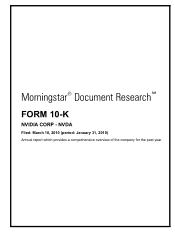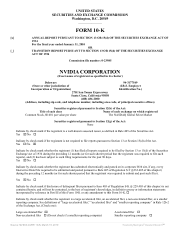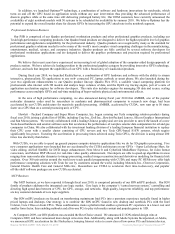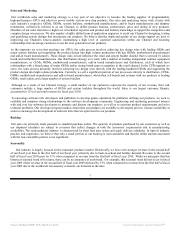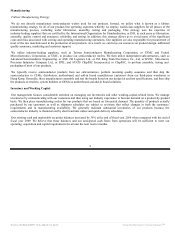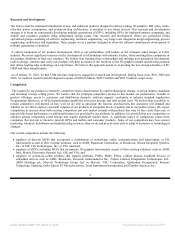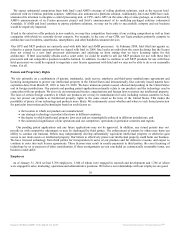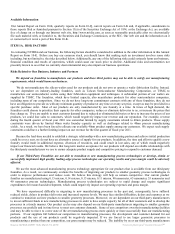NVIDIA 2010 Annual Report Download - page 10
Download and view the complete annual report
Please find page 10 of the 2010 NVIDIA annual report below. You can navigate through the pages in the report by either clicking on the pages listed below, or by using the keyword search tool below to find specific information within the annual report.
During fiscal year 2010, we began redirecting our development strategy in our MCP business in response to our on-going
dispute with Intel Corporation. In February 2009, Intel filed suit against us, related to a chipset license agreement that we entered into
with Intel in 2004. In March 2009, we asserted counterclaims against Intel pursuant to which we seek an order declaring that Intel
breached the chipset license agreement as well as the implied covenant of good faith and fair dealing underlying the license
agreements, and seeking, among other things, termination of Intel’s cross license to our technology. Notwithstanding our belief that
the chipset license agreement extends to a component of the new Intel processor architecture referred to as Direct Media Interface, or
DMI, we currently have no intention of building a DMI-based chipset while this dispute remains unresolved. As a result, we began
redirecting our MCP development resources to other programs. Please refer to Note 13 of the Notes to the Consolidated Financial
Statements in Part IV, Item 15 of this Form 10-K for further information regarding this litigation
Consumer Products Business
Our CPB is comprised of our Tegra mobile products that support smartphones, smartbooks, tablets, personal media players, or
PMPs, internet television, automotive navigation, and other similar devices. CPB also includes license, royalty, other revenue and
associated costs related to video game consoles and other digital consumer electronics devices.
Our mobile strategy is to create a system-on-a-chip that enables entertainment and web experiences that end users currently enjoy on
a PC. NVIDIA Tegra mobile products implement design techniques, both inside the chips and at the system level, which result in high
performance and long battery life. These technologies enhance visual display capabilities, improve connectivity, and minimize chip
and system-level power consumption.
During fiscal year 2010, we demonstrated the Tegra 600 Series, our first generation system-on-a-chip that enables an
always-on, always-connected HD smartbook that offers playback of advanced multimedia content such as 720p HD video, while at the
same time consuming minimal power and allowing users to go days between battery charges. Also during fiscal year 2010, our Tegra
product was included in Microsoft’s Zune HD and the Samsung M1, both of which were being sold in the marketplace.
During the recent Consumer Electronics Show in January 2010, we announced our next-generation of Tegra processing
technology. Tegra is the processor for the mobile web, specifically designed for the high-resolution needs of tablets. Tegra combines
browsing, streaming 1080p video and Flash 10.1 acceleration with a 3D user interface and days of battery life. We have multiple
next-generation Tegra design wins in tablets, smartbooks and smartphones, with the first of these expected to ship during the second
quarter of fiscal year 2011. Additionally, we have announced that Volkswagen and Audi will use next-generation Tegra starting in
fiscal year 2012.In addition, we announced 3D Vision Surround for GeForce, a high-definition 3D stereo solution for the home at the
recent Consumer Electronics Show in January 2010. 3D Vision is a combination of wireless glasses, a high-power infrared emitter and
software that transforms PC games into full stereoscopic 3D experiences. Over 420 games now support NVIDIA 3D Vision.
5
Source: NVIDIA CORP, 10-K, March 18, 2010 Powered by Morningstar® Document Research℠

